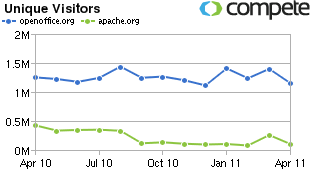True confessions: I’ve been using OpenOffice since 2002 (since I started working at Red Hat, where it was mandated) and… I don’t like it (*gasp* – did he just say that?). Yep, it’s true. OpenOffice is just not that great of a user experience. Microsoft Office, with all it’s bloat, is better. Apple iWork is even better – that is - from the perspective of an end user. But you know what? It doesn’t matter what I think. That’s because the real value of OpenOffice is not the end-user experience – it’s the fact that OpenOffice is a powerful, open content creation platform.
I will let other people debate Oracle’s motivations, Apache vs. The Document Foundation (TDF), etc. but here are a few interesting facts: OpenOffice is one of the most successful and vast open source projects in the world (1.2 million downloads a week and 135 million known distributions). OpenOffice.org gets 10x the number of unique visitors as the Apache.org homepage itself, according to Compete. By measures of downloads and web traffic, OpenOffice is as relevant as ever.
So here’s what I am wondering: what happens when you mash-up a project with a huge community of use (OpenOffice.org) with a powerful, developer-centric community (Apache)? What happens when you take a powerful, open source content platform that has already thought about the hard stuff around content creation, and unleash it on a developer community who can think of new and compelling ways to plug that functionality into all kinds of apps? What happens when you adopt a new, more permissible license that encourages companies to innovate and embed OpenOffice without as many limitations?
 Innovation happens. Cloud apps get richer in-browser editing without having to start from scratch. Vertical markets – healthcare? manufacturing? finance? – get slimmed-down, purpose-built productivity and content tools that allow them to avoid all of the Microsoft bloat (and cost) and give their users exactly what they need to get the job done. Developing nations get a powerful, free productivity suite in whatever obscure language they need. The line between offline and online editing gets blurred, with unique integrations (save to Evernote? save to iCloud? offline editing tool for WordPress blogs? integration with Skype presence or Google Apps?). And, with the power of the OpenOffice brand, web traffic, and distribution network, there are already 100 million users eager to download and try these solutions.
Innovation happens. Cloud apps get richer in-browser editing without having to start from scratch. Vertical markets – healthcare? manufacturing? finance? – get slimmed-down, purpose-built productivity and content tools that allow them to avoid all of the Microsoft bloat (and cost) and give their users exactly what they need to get the job done. Developing nations get a powerful, free productivity suite in whatever obscure language they need. The line between offline and online editing gets blurred, with unique integrations (save to Evernote? save to iCloud? offline editing tool for WordPress blogs? integration with Skype presence or Google Apps?). And, with the power of the OpenOffice brand, web traffic, and distribution network, there are already 100 million users eager to download and try these solutions.
OpenOffice couldn’t survive inside of Sun & Oracle because Sun & Oracle don’t sell to users – they sell to corporations. Let’s celebrate that OpenOffice will now be in a place (and with a license) where its natural position as a powerful content creation platform can blossom to accelerate innovation in a space that desperately needs new ideas.
This article was originally posted on socialcontent.com.




9 Comments